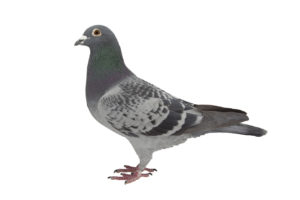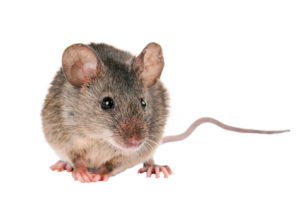Mice
The house mouse is a common pest in houses and outbuildings. It is well adapted to sharing our living space and resources and has been doing so for thousands of years. These little pests can share other things with us too: like diseases and parasites. This column will explain their life cycle and habits along with some management strategies to minimize their negative effects.
House mice are much smaller than rats and can be distinguished from a juvenile rat by their smaller feet and head. Their fur is usually a dusty gray above and cream colored on the belly. They can also be identified by their droppings which are 1/8 to 1/4” inch (3 to 6 mm) long and rod-shaped with pointed ends. One mouse produces 50 droppings per day. Other signs of house mice are: gnaw marks on wood, cardboard, and soft plastic; tracks/footprints (4 toes on the front 5 toes on the rear feet); rub marks (dirty areas along base boards and walls); and damaged goods such as cereals and seeds. House mice reach sexual maturity in 35 days and the female’s gestation period averages 19 days. The young are born blind and hairless except for whiskers and are weaned after about 3 to 4 weeks. Average litter size is 6 and each female can have up to 8 litters per year. Mice may infest buildings year-round, but are more likely to invade structures in the fall.
Mice are mainly nocturnal but can sometimes be seen during the day. They have keen senses of smell and hearing but poor eyesight. On a rough surface, they can run up a wall, jump 12” up in the air, and can jump down 8 feet and survive. A mouse requires 1/10 oz. of food per day. Free water is not necessary because they can extract it from their food. However, if free water is available, they will drink. They really like sweetened beverages such as cherry flavor Kool-Aid and prune juice. Mice are very inquisitive. If something has changed position or is out of place, they will explore it and adjust their travel routes accordingly. There are two main feeding periods: dusk and just before dawn. They will also nibble on small amounts of food anytime. They prefer to nest in dark, secluded places with abundant nesting material close by. The material may be cotton, packing material, insulation, or fabric. Adult mice can also squeeze through an opening 1/4” or larger to gain entry.
The most threatening health issue with mice is their ability to spread Salmonella bacteria in their droppings. This organism is a common cause of food poisoning. Other transmittable organisms are tapeworms, rat-bite fever, infectious jaundice/leptospirosis/, plague, Hantavirus, and possibly poliomyelitis (polio). Given these potentially life threatening diseases, mice should not be tolerated in your living space.
To reduce indoor mouse populations, you should start by trying to exclude them and eliminate access to food sources, water and shelter. If this is done and the problem continues, then you should consider population control. The old standby is the snap trap set and placed along a well-traveled wall. I usually bait traps with peanut butter, oat flakes, and bits of raisin. Glue boards and sticky traps are also available, but are considered less humane. Do not touch the dead mice (or any dead animal) with bare hands. Use disposable rubber gloves or a plastic bag over your hand, bag the dead mouse, and discard in an outdoor waste receptacle. Wash thoroughly with soap and water after disposal.
Toxicants (poison baits) and anti-coagulant rodenticides can be used as well, but the dead mice may smell badly if they die inside the house. Multi-capture, live traps also work well. One of these is called the “Tin Cat”. They enter and cannot exit. Once one mouse enters, other mice also become curious and enter too. With these devices, you will need to decide how to dispose of the live mice once they are caught. Pest control professionals often use carbon dioxide chambers to humanely asphyxiate trapped animals. The presence of mice in sheds and barns often attracts other predators including snakes, owls, coyotes, bobcats, and foxes. Cats and dogs can also help control mice. This time honored tradition works fairly well, but they don’t need to go hungry to encourage them to hunt. Supplemental food should always be provided.
Pigeons

Pigeons can be entertaining to watch, but their droppings can cause damage to buildings and spread diseases to people and other animals.[1] You can prevent this from happening, namely through deterrents and humane population control. Before you take any measures, check your national and local laws concerning their protection status and which control methods you may use.
Pigeon Control http://www.wikihow.com/Get-Rid-of-Pigeons

